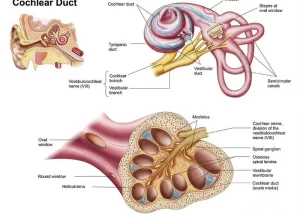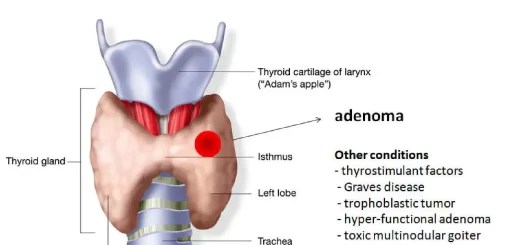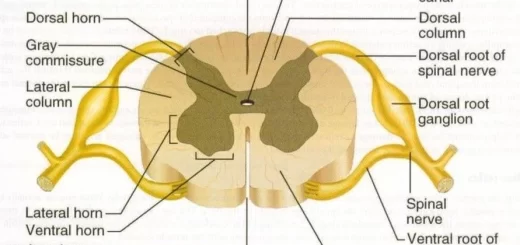Auditory system structure and function, Auditory apparatus, cochlea and cochlear duct
The cochlea is a cone-shaped spiral bony canal, 3.5 cm long that makes 2¾ turns around a bony axis, the modiolus which houses the spiral ganglion of the cochlear nerve. In histological sections, the lumen of the bony cochlear canal is divided into three spiral chambers or scalae. The scala vestibuli above, scala tympani below, and in between is the scala media which is triangular in cross-section.
Cochlea
At the apex of the cochlea, the scala vestibuli and the scala tympani communicate with each other through a small opening, the helicotrema. At the base of the cochlea, the scala vestibuli begins at the oval window and the scala tympani ends at the round window.
The scala media (the membranous cochlear duct) contains the spiral organ of the Corti. It is the sensory organ of hearing which extends along the entire length of the cochlea from the apex to the base.
The membranous cochlear duct contains endolymph and is surrounded by the perilymph present in scala vestibuli and scala tympani. The cochlear duct is continuous with the saccule of the bony vestibule and ends at the apex of the cochlea.
Boundaries of the cochlear duct (the scala media)
Its floor is formed by the fibro-elastic basilar membrane which extends from the modiolus to the lateral wall of the bony cochlea, The organ of the Corti rests on the basilar membrane, The roof of the duct is formed by the vestibular membrane (Reissner’s membrane) which is formed of two layers of squamous epithelium.
The lateral boundary of the cochlear duct is formed by the stria vascularis which is a vascularized cuboidal epithelium covering the periosteum. It is responsible for the production of the endolymph.
Histological structure of the organ of Corti
It is composed of the following:
I. Supporting cells:
There are several types of supporting cells, resting on the basilar membrane and containing bundles of microtubules and microfilaments. They include:
- Inner and outer pillar cells (Rods of Corti: they surround and support the tunnel of Corti.
- Inner and outer phalangeal cells: they are found on both sides of the pillar cells. They are columnar cells, each has a cup-shaped apical portion that supports the rounded bases of the outer and inner hair cells respectively.
II. Inner and outer hair cells: these are specialized neuroepithelial cells which include:
- The inner hair cells: there is one row of inner hair cells medial to the tunnel of Corti (lying closer to the modiolus). They are flask-shaped with basal nuclei. From 30-170, stereocilia (hairs) arise from the free end of each cell and are arranged in a V-shaped pattern.
- The outer hair cells: there are 3-5 rows of outer hair cells lateral to the tunnel of Corti. They are columnar in shape. Stereocilia projecting from the free end of each cell are arranged in a W-shaped pattern.
Hair cells do not directly rest on the basilar membrane, but their rounded bases lie in the cup-shaped recesses of the corresponding phalangeal cells. The basal aspects of hair cells synapse with the afferent fibers of the cochlear division of VIll nerve.
III. The tectorial membrane:
It is a gelatinous mass containing numerous collagen fibrils, It is attached medially to the modiolus, while its lateral free edge projects to cover the organ of Corti, The apical ends of the phalangeal cells are tightly bound to one another and to that of hair cells by the tight junction. These junctions form the tough, membrane-like reticular lamina. The stereocilia of hair cells pierce the reticular lamina and become embedded into the under-surface of the tectorial membrane.
Physiology of hearing
Hearing is the neural perception of sound energy.
Physical nature of sound
Sound is characterized by its pitch (frequency), intensity (loudness=volume), and timbre (quality).
Pitch or frequency: The audible range extends in humans from 20 to about 20.000 c/sec. (Hz) the greatest sensitivity is from 1000 to 4000 Hz, discrimination decreases above 4000 Hz.
The intensity of sound (loudness or volume): Loudness is measured in decibels (dB). Sounds of intensity greater than 130 dB can permanently damage the sensitive sensory apparatus at the base of the cochlea. The minimal sound pressure detected by the human ear (the threshold value) is 0.000204 dynes/cm². It is the zero (0) decibel.
The timbre or quality: The timbre, or quality of sound, depends on its overtones, which are additional frequencies superimposed on the fundamental pitch or tone.
Functions of external ear
The pinna acts as a sound collector. The external auditory canal affords protection against physical trauma; it can vibrate when the wavelength of sound is 4 times the length of the tube. The external ear resonance adds 15-20 dB to the sound pressure at the tympanic membrane. Sound localization in space: the external ear plays a role in sound localization by changes in pressure on the tympanic membrane.
Function of the tympanic membrane
The tympanic membrane moves in and out in response to pressure changes produced by sound waves on its external surface so it acts as a resonator, the physiological surface area is 55 mm².
Functions of the middle ear
1. Conduction of sound from the tympanic membrane to the cochlea
a. Amplification of sound intensity: two mechanical devices are built in the middle ear that amplify sound pressure that arrives at the oval window. These are:
- The lever action of the malleus and incus: the malleus and incus act as a lever. The malleus arm is longer than the incus arm in a ratio of 1.3 to 1. This system does not increase the distance of movement of the stapes, but it increases the force of movement at the incus and footplate of the stapes by 1.3 times.
- The areal ratio of the tympanic membrane and oval window: the force exerted over the large tympanic membrane (55mm²) is concentrated on the tiny footplate of the stapes (3.2 mm²) with a gain in pressure equals the surface area of the larger divided by the smaller (55/3.2) = 17. This 17-fold difference times the 1.3-fold ratio of the lever system causes about 22 times as much total force to be exerted on the cochlear fluid which has greater inertia than air.
b. Impedance matching by the ossicular system: the function of the middle ear is to transfer sound energy from a gas to a liquid medium without great loss of energy. Therefore, the tympanic membrane and the ossicular system provide impedance matching between the sound waves in the air and sound vibrations in the cochlear fluid impedance matching allows the utilization of most of the energy of the incoming sound waves.
c. Sound protection of the round window: bulging of the round window towards the middle ear due to the pressure energy of sound in scala tympani, it serves as a pressure relief hole that prevents overlap between the successive waves, so it allows discrimination of sound waves inside the cochlea.
2. Function of middle ear muscles
Tympanic muscle reflexes (attenuation reflex): The stapedius and tensor tympani muscles act directly upon the ossicular chain. They contract reflexly in response to sounds of high intensity (above 80 dB) and low frequency below 1 KHz = 1000 cycles/second). The contraction of the two muscles acts as two forces leading to the entire rigidity of the ossicular chain. that greatly reduces the transmission of loud sounds.
This is called the attenuation reflex. It starts at the cochlea (the stimulus is the high-intensity and low-frequency sound), then through the cochlear nuclei, superior olivary nucleus, and inferior colliculus (the center of the reflex) to the motor nuclei of the V and VIl cranial nerves to the tensor tympani and stapedius muscles respectively. The reflex is consensual whether the sound stimulus is applied to one or both ears. The reflex occurs after a latent period of 40-80 milliseconds.
You can subscribe to Science Online on YouTube from this link: Science Online
Physiology of equilibrium, Hearing, ear balance, Function & Stimulants of Semicircular canals
Ear anatomy, structure, function, Relations of middle ear & Action of Auditory muscles
Histological organization of vestibular apparatus, Hearing importance & body Equilibrium
Hearing, Transmission of sound waves in Cochlea, Functions of Cochlea & Auditory pathway




